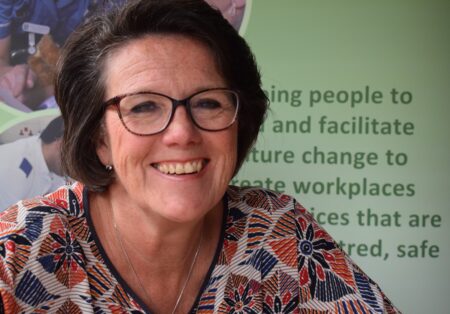Home News & Views Creating a safe learning environment in a virtual world
Creating a safe learning environment in a virtual world

Jo Odell; Practice Development Facilitator
Recently I came across a blog by Alison Trimble at the Kings Fund, written back in May. Alison talks about the need to create a safe space for people when they feel stressed and anxious because of the Covid pandemic. She also talks about the importance of developing and maintaining relationships with colleagues.
Here at FoNS we value working with people in collaborative, inclusive and participatory ways (Manley et al., 2013) and we believe that creating a safe space for learning is essential all the time which will help us respond effectively in normal times and extraordinary circumstances like the Covid-19 pandemic has highlighted. Without this “learning space” research suggests that health and social care staff can suffer emotional and physiological effects from their role. Whilst they can go on to develop strategies to help them cope, this might involve them distancing themselves from distress by avoiding meaningful engagement with patients and families. Such strategies can be perceived as a lack of care and kindness expressed towards others and are often seen in staff experiencing what is known as compassion fatigue. (Knobloch Coetzee and Klopper, 2010)
Up until the pandemic, FoNS’ programmes involved face-to face workshops. Underpinning these are collaborative, inclusive and participatory ways of working, such as:
- Developing shared safe space agreements, identifying the values that are important and associated behaviours to enable trust to build up in the group, so creating a positive learning environment
- Spending time getting to know the person rather than their role
- Valuing experience as a form of knowledge, sharing stories and using creativity to help us reflect on practice
- Sharing decision-making about the programme content
- Collectively evaluating the workshop days and programmes
- Using an active learning or learner led approach
I am the facilitator for the FoNS Inspire Improvement Fellowship and working with the fellows ( Clinical Nurse Leaders) on six workshops using the above methods along side personal workplace support, have not only resulted in improvements in care and their workplace culture, but have enabled, the development of an independent community of practice (Wenger et al (2002), that enables support, resilience and self-facilitation. This has enabled the fellows to sustain working in person-centred ways and seek inspiration from each other and reduce individual isolation. Indeed, they are generating new ways of working to provide each other with continued support and have voluntarily co-facilitated an evaluation workshop with new cohorts so developing a larger community of practice as each cohort joins the programme. They actively stay in touch using social media, despite the official end of their programmes. I was expecting to start working with a new group of 12 nurses (cohort 3) back in March. As with many workstreams, the programme had to be postponed; but five months later, we are now all re connecting and beginning to explore the ways in which we want and can work together.
As a result of the Covid-19 pandemic learning environments have moved away from face to face towards the virtual space, either through zoom or MS teams. As a team we have been reflecting on how we can create the same active learning experience for participants in the virtual space as we did in the workshops and will we be able to create the same community of practice that was achieved with the first two cohorts.
After discussion with a colleague, we believe we can create an active learning environment via zoom for example, however we are worried about losing the conversations that participants would have over meals and whilst staying away for the workshop days, so important in creating relationships, trust and ultimately a community of practice. As I and cohort three fellows start working together in September, it will be interesting to see what we can achieve and whether it’s possible to build up trust and relationships quickly via a virtual platform. And to compare that to the great relationships that have been formed with the two previous cohorts of the fellowship. As observed by Year 2 fellow of Year 1 fellows at a joint workshop in June 2019, “there is a lot of love and friendship in the room and that is very clear to see.”
Well watch this space and I will keep you updated on how we get on.
References
Knobloch Coetzee, S and Klopper, H (2010) Compassion fatigue within nursing practice: a concept analysis. Nursing and Health Sciences Vol. 12. No. 2. pp235-243.
Manley, K., and Titchen, A., McCormack, B (2013). Chapter 3: What is Practice Development and what are the starting points In: Practice Development in Nursing and Healthcare. Second Edition (ed. B. McCormack, K. Manley, and A. Titchen) pg 50-51. Chichester: Wiley Blackwell.
Wenger, E., McDermott, R. A., Snyder, W (2002). Cultivating communities of practice: a guide to managing knowledge. Boston, Mass., Harvard Business School Press.
Comments are closed.

